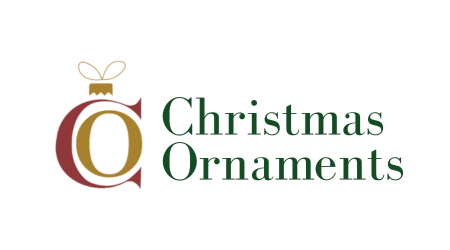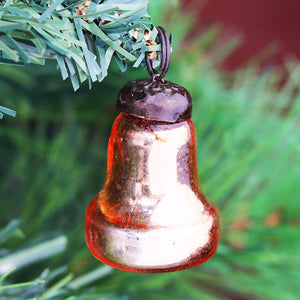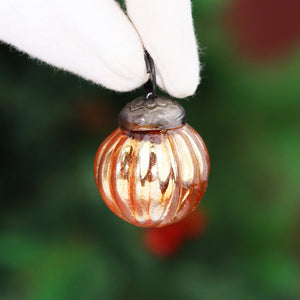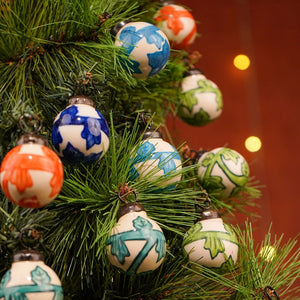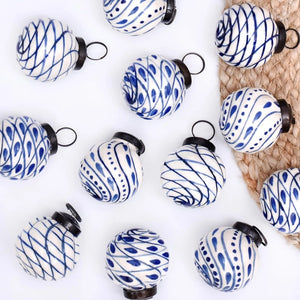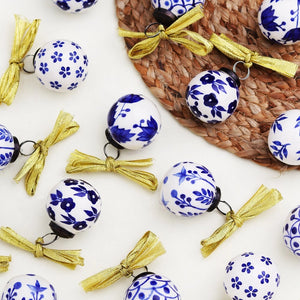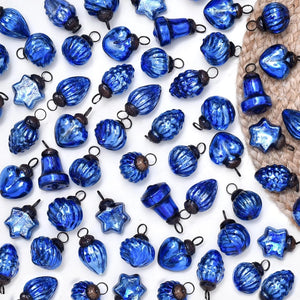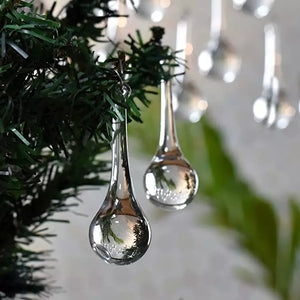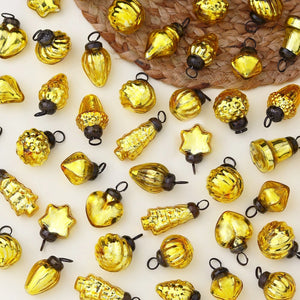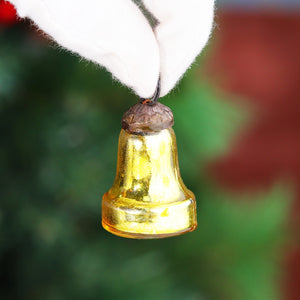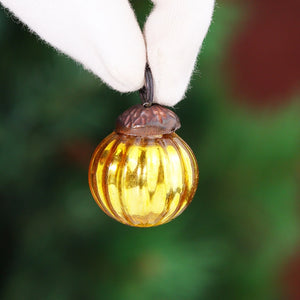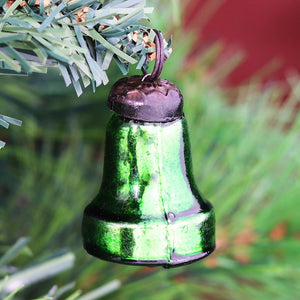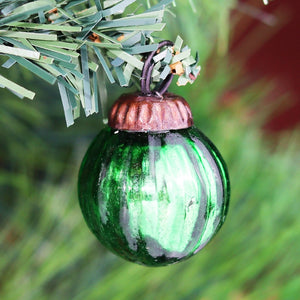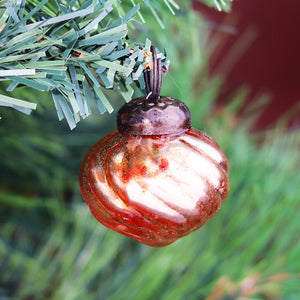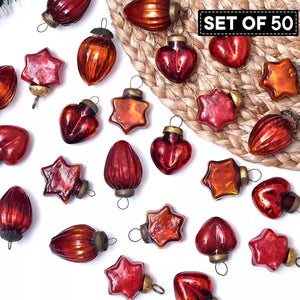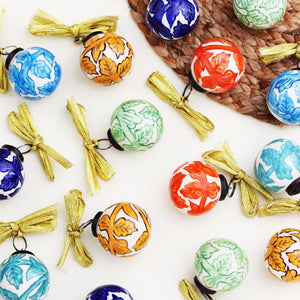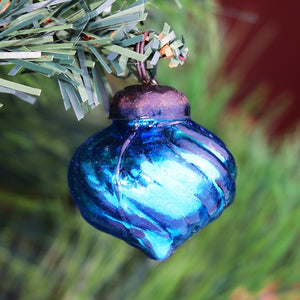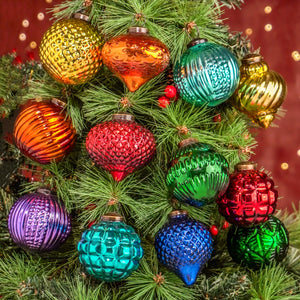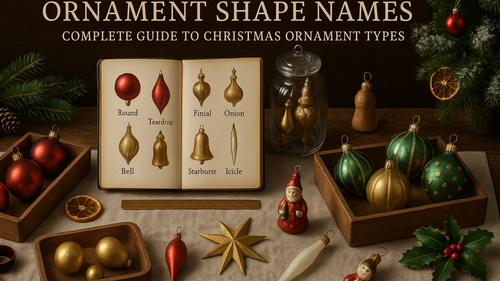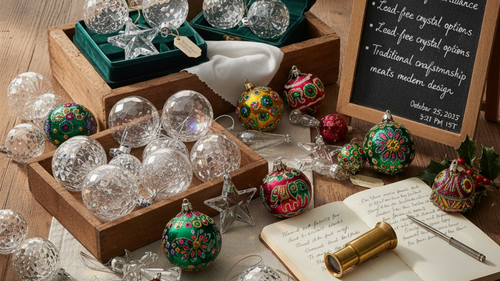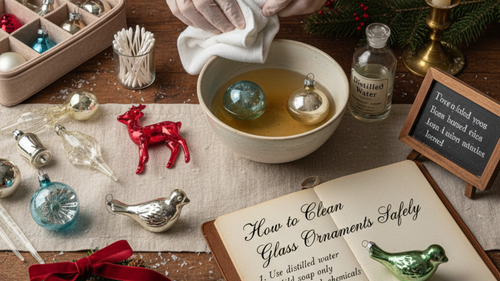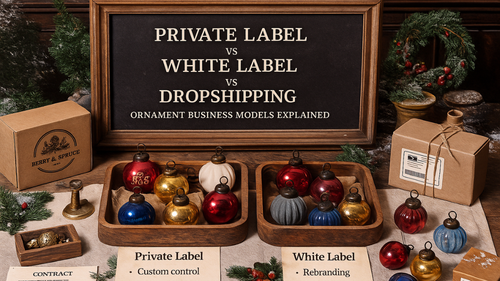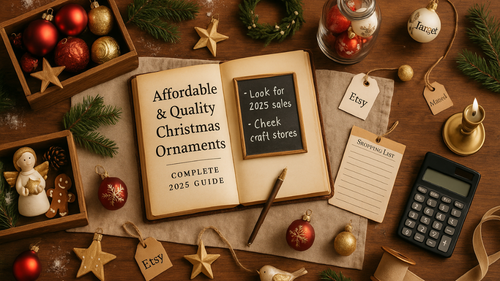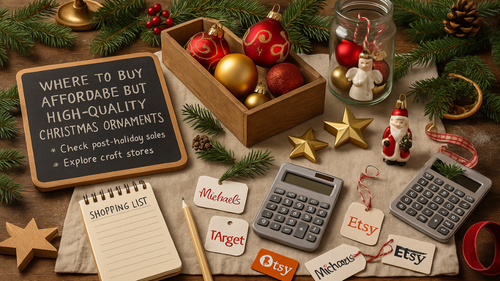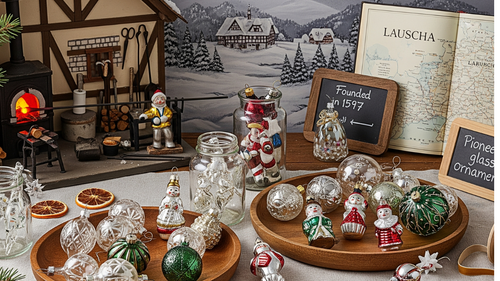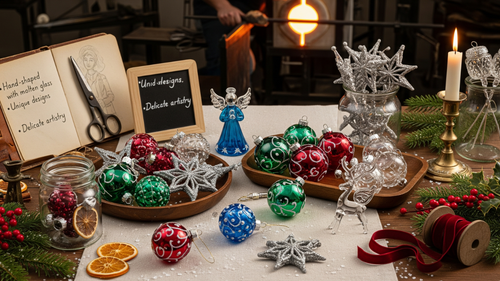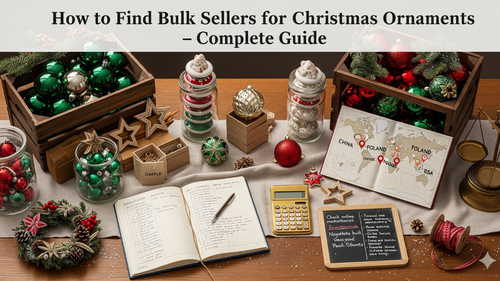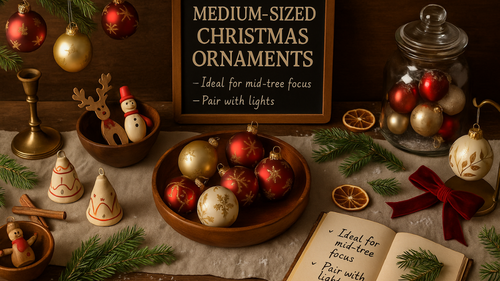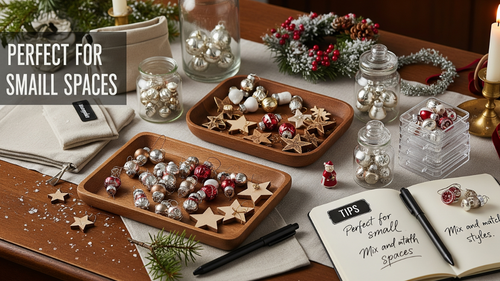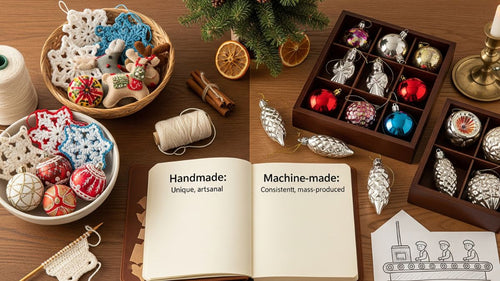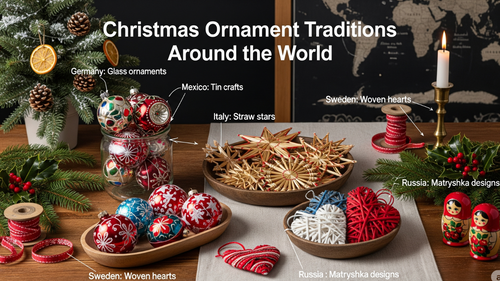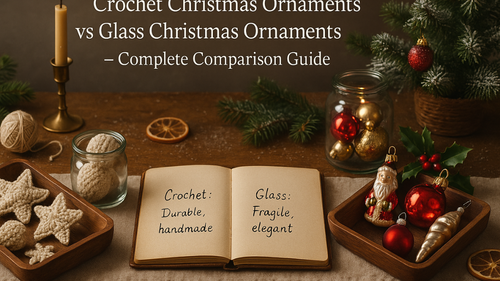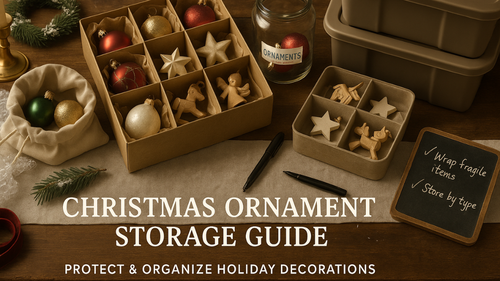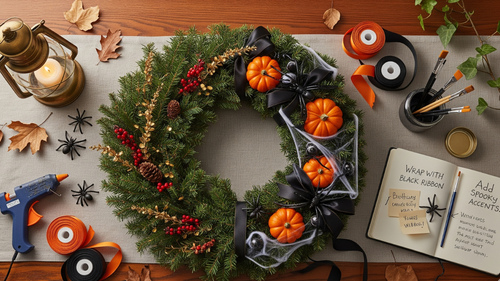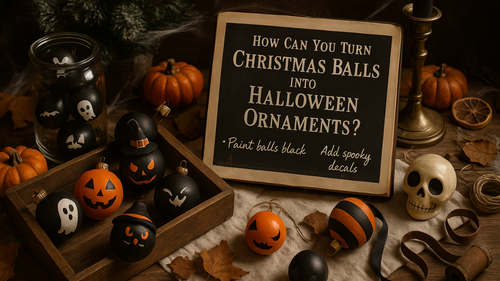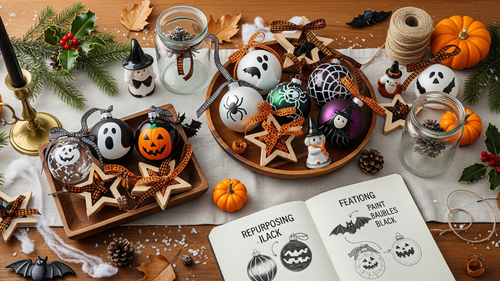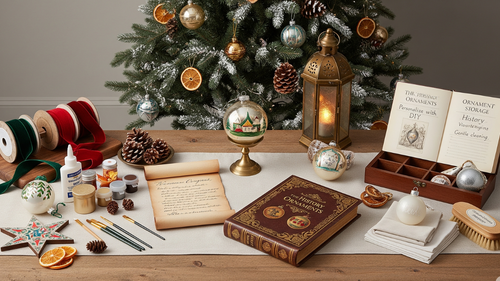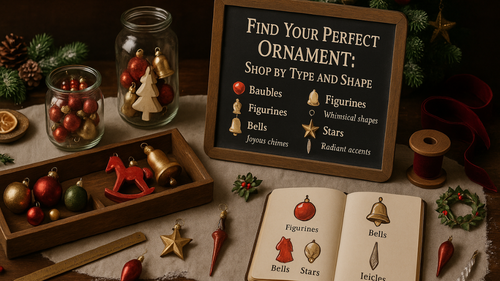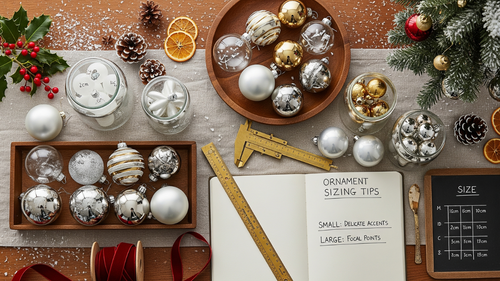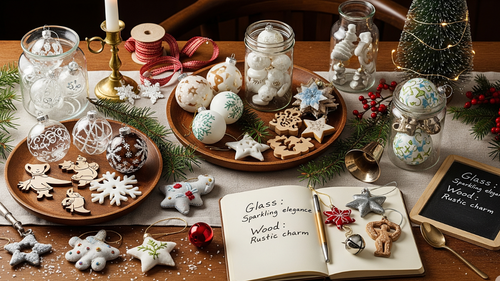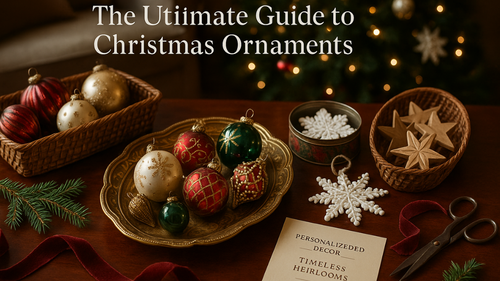The holiday decorating season brings excitement, but also confusion about terminology. Many decorators wonder whether they should buy "baubles" or "ornaments" for their Christmas tree. Understanding this distinction becomes crucial when shopping for holiday decorations, especially with the Christmas decoration market reaching $5.33 billion in 2024 and growing at 5.42% annually toward $7.32 billion by 2030.
This comprehensive guide clarifies the difference between baubles and ornaments, explores their historical origins, regional usage variations, and provides practical shopping advice. Whether you're a first-time decorator or seasoned holiday enthusiast, this article helps you navigate the terminology and make informed decoration choices.
Baubles are specifically ball-shaped decorations - those spherical glass or plastic ornaments that hang on Christmas trees. Ornaments is the broader umbrella term encompassing all Christmas tree decorations, including baubles, stars, angels, figurines, icicles, and specialty shapes. Every bauble is an ornament, but not every ornament is a bauble.
Featured Products
Table of Contents
Christmas ornaments include every decorative item designed for tree display:
- Key Takeaways
- Understanding Baubles vs Ornaments: Core Definitions
- Historical Origins and Cultural Development
- Types and Categories of Christmas Decorations
- Material Differences and Manufacturing
- Shopping Guide: When to Choose Baubles vs Ornaments
- 2024-2025 Trends in Holiday Decorations
- Seasonal Availability and Shopping Timing
- Practical Decorating Tips and Best Practices
- Practical Decorating Tips and Best Practices
- Frequently Asked Questions
- Conclusion
Key Takeaways
- Baubles are spherical ornaments: Round, ball-shaped decorations made from glass, plastic, or metal.
- Ornaments include everything: Baubles, stars, angels, figurines, icicles, and all tree decorations.
- Regional terminology matters: UK prefers "baubles," US uses "ball ornaments" or "Christmas balls"
- Historical significance: Baubles originated in 1840s Germany, spreading globally through trade
- Material evolution: From handblown glass to modern shatterproof alternatives
- Shopping strategy: Use baubles for base coverage, ornaments for focal points, and themes
Understanding Baubles vs Ornaments: Core Definitions
Baubles are specifically spherical, ball-shaped Christmas decorations, while ornaments represent the complete category of all Christmas tree decorations. This fundamental distinction shapes shopping decisions, decoration strategies, and regional terminology preferences. Understanding these core definitions eliminates confusion and enables confident holiday decoration planning.
Visual Comparison Table
| Term | Definition | Common Region | Shapes Included | Example Usage |
|---|---|---|---|---|
| Baubles | Spherical decorations only | UK/Commonwealth | Ball, onion, finial drop | "Glass baubles for tree" |
| Ornaments | All Christmas tree décor | US/Canada | Stars, angels, figurines, baubles | "Christmas ornament collection" |
| Christmas Balls | Round ornaments specifically | US retail | Balls only | "Shatterproof Christmas balls" |
| Holiday Balls | Spherical seasonal décor | Global retail | Round shapes | "Holiday ball ornament sets" |
| Tree Decorations | British term for all ornaments | UK formal | All shapes and types | "Christmas tree decorations" |
International Terminology Glossary
- United Kingdom: Baubles (spherical), Tree decorations (all types)
- United States: Ornaments (all types), Ball ornaments (spherical)
- Germany: Weihnachtskugeln (Christmas balls), Weihnachtsschmuck (all decorations)
- France: Boules de Noël (Christmas balls), Décorations de Noël (all ornaments)
- Spain: Bolas navideñas (Christmas balls), Adornos navideños (decorations)
- Italy: Palle di Natale (Christmas balls), Decorazioni natalizie (decorations)
What Are Baubles?
Baubles represent a specific subset of Christmas decorations characterized by their spherical shape. The term derives from the 14th-century Old French word "baubel," meaning a child's toy or trinket. In modern holiday decorating, baubles refer exclusively to round, ball-shaped ornaments that hang from Christmas tree branches.
Featured Products
Traditional baubles feature hollow interiors with decorative caps and hanging loops. They come in various sizes, typically ranging from 2 inches to 6 inches in diameter. The most common bauble types include:
- Glass baubles: Hand-blown or machine-made glass spheres with metallic finishes
- Shatterproof baubles: Plastic alternatives that mimic glass appearance
- Metallic baubles: Metal-constructed spheres with brushed or polished finishes
- Matte baubles: Non-reflective surface treatments in solid colors
What Are Ornaments?
Ornaments encompass the entire category of Christmas tree decorations. This umbrella term includes baubles alongside countless other decorative elements. The word "ornament" traces back to Latin "ornamentum," meaning equipment or decoration.
Synonym and Search Term Variations
Holiday decoration terminology includes numerous synonyms and regional variations that affect online searching and product discovery. Understanding these alternatives helps decorators find desired products across different retailers and geographic markets.
Featured Products
Bauble Synonyms:
- "Christmas balls" - Primary US retail term
- "Holiday balls" - Broader seasonal usage including non-Christmas applications
- "Glass balls" - Material-specific terminology
- "Festive spheres" - Formal or upscale marketing language
- "Tree balls" - Descriptive usage emphasizing placement
Ornament Synonyms:
- "Christmas tree decorations" - British formal terminology
- "Holiday decorations" - Inclusive seasonal language
- "Tree décor" - Shortened contemporary usage
- "Festive ornaments" - Marketing language emphasizing celebration
- "Christmas collectibles" - Emphasis on keepsake value
- Baubles and balls: Spherical decorations in various materials
- Figurines: Angels, Santa figures, animals, and characters
- Shaped ornaments: Stars, hearts, snowflakes, and geometric forms
- Icicles: Elongated hanging decorations mimicking ice formations
- Specialty ornaments: Photo frames, personalized items, and themed pieces
- Natural ornaments: Pinecones, dried fruits, and handcrafted items
Historical Origins and Cultural Development
Baubles originated in 1840s Germany as practical replacements for fragile fruit decorations, while the broader ornament category evolved through centuries of cultural traditions and manufacturing innovations. German glassblower Hans Greiner revolutionized Christmas decorating in 1847 by creating the first blown-glass Christmas balls. This innovation spread globally through trade networks, establishing the foundation for modern holiday decoration industries.
Featured Products
Historical Timeline: From Fruit to Glass to Modern
| Year | Development | Impact |
|---|---|---|
| 1500s-1600s | Edible ornaments (fruits, nuts, gingerbread) | Established tree decoration tradition |
| 1847 | Hans Greiner creates first glass baubles in Lauscha, Germany | Revolutionary durable alternative to fruit |
| 1870s | German baubles reach American markets | Global expansion of bauble tradition |
| 1940s-1950s | Shiny Brite mass-produces affordable glass balls in US | Democratizes ornament access |
| 1960s-1970s | Shatterproof plastic baubles introduced | Safety revolution for family decorating |
| 2020s | Sustainable materials and smart technology integration | Environmental consciousness meets innovation |
How Did Baubles Begin?
The bauble tradition began in 16th-century Germany, where families decorated Christmas trees with edible ornaments including fruits, nuts, and gingerbread. The breakthrough came in 1847 when Hans Greiner in Lauscha, Germany, created the first blown-glass Christmas balls, revolutionizing holiday decorating.
These early glass baubles replaced fragile fruit decorations with durable, reusable alternatives. German glassblowers perfected techniques for creating thin-walled spheres with metallic interior coatings, establishing the template for modern baubles.
The tradition spread rapidly across Europe through trade networks. By the 1870s, German-made glass baubles reached American markets, transforming Christmas celebrations in the United States.
Evolution of Ornament Terminology
While baubles maintained their specific spherical identity, the term "ornament" expanded to accommodate growing decoration varieties. Victorian-era manufacturers introduced metal, fabric, and ceramic alternatives to supplement glass baubles.
Post-World War II manufacturing innovations brought mass-produced ornaments to mainstream consumers. Companies like Shiny Brite in the United States popularized affordable glass ball sets, cementing "ornaments" as the preferred American retail term.
The 1960s-70s witnessed the shatterproof revolution. Plastic manufacturing technology enabled safe, family-friendly bauble alternatives, expanding the market to households with children and pets.
Regional Usage: UK vs US vs Global Terminology
British speakers prefer "baubles" for spherical decorations and "tree decorations" broadly, while Americans use "ornaments" as the umbrella term with "ball ornaments" specifying spheres. These regional preferences reflect historical linguistic development and retail marketing strategies. Understanding regional terminology helps international shoppers navigate different markets and communicate decoration preferences effectively.
United Kingdom and Commonwealth Countries
British English speakers predominantly use "baubles" when referring to spherical Christmas decorations. UK retailers organize products into "bauble" categories, distinguishing between traditional glass baubles and modern shatterproof alternatives.
British holiday vocabulary includes specific terms:
- "Christmas baubles" for spherical decorations
- "Tree decorations" as the broader category
- "Hanging ornaments" for non-spherical decorative items
United States and Canadian Usage
American English favors "ornaments" as the primary term, with "ball ornaments" or "Christmas balls" specifying spherical decorations. This linguistic preference reflects retail categorization strategies in North American markets.
US holiday terminology patterns:
- "Christmas ornaments" encompasses all tree decorations
- "Ball ornaments" specifically refers to baubles
- "Holiday decorations" includes ornaments plus broader seasonal décor
Global and European Variations
German speakers use "Weihnachtskugeln" (Christmas balls) for baubles and "Weihnachtsschmuck" for all ornaments. French terminology includes "boules de Noël" for baubles and "décorations de Noël" for ornaments generally.
This linguistic diversity reflects cultural approaches to holiday decorating, with each region developing distinct vocabulary based on historical traditions and modern retail practices.
Types and Categories of Christmas Decorations
Baubles encompass only spherical decorations in various materials and finishes, while ornaments include geometric shapes, figurines, natural elements, and specialty designs. This categorization system helps decorators understand product ranges and make strategic purchasing decisions. Modern manufacturing produces baubles in glass, plastic, and metal, while ornaments span countless materials and artistic styles.
Comprehensive Bauble Categories
Traditional Glass Baubles: Hand-blown or machine-manufactured glass spheres remain the premium choice for elegant holiday displays. These baubles feature metallic interior coatings creating lustrous finishes in gold, silver, copper, and contemporary colors.
Shatterproof Baubles: Plastic construction provides safety without sacrificing visual appeal. Modern manufacturing techniques create realistic glass-like appearances while eliminating breakage concerns for families with children or pets.
Specialty Baubles: Contemporary designs include textured surfaces, matte finishes, glitter applications, and custom printing options. Some feature LED lighting integration or interactive elements.
Ornament Shape Classifications
Beyond spherical baubles, ornaments encompass diverse geometric and representational forms:
Geometric Shapes: Stars, snowflakes, diamonds, teardrops, and abstract forms provide structural variety. These shapes create visual interest through contrast with round baubles.
Figurative Ornaments: Angels, Santa figures, reindeer, snowmen, and religious symbols add thematic storytelling elements. Handcrafted figurines and ceramic baubles are trending in 2024-2025 as consumers seek personalized decoration experiences.
Natural and Rustic Ornaments: Pinecones, dried fruit slices, wooden cutouts, and fabric decorations align with growing sustainability preferences. 75% of consumers want sustainable holiday options according to recent market research.
Material Differences and Manufacturing
Baubles primarily use glass, plastic, and metal due to spherical shape requirements and manufacturing limitations. Ornaments utilize unlimited material options including ceramics, wood, fabric, paper, and natural elements because diverse shapes accommodate varied construction methods. This material flexibility explains why ornament prices range more dramatically than standardized bauble pricing structures.
Bauble Manufacturing Materials
Traditional Glass: Soda-lime glass remains the premium material for high-end baubles. Manufacturing involves heating glass to 2000°F, blowing into spherical molds, and applying metallic coatings through specialized vapor deposition processes.
Shatterproof Plastics: Polystyrene and acrylic materials dominate family-friendly bauble production. These materials resist breaking while maintaining optical clarity and accepting decorative treatments.
Metal Baubles: Aluminum and stainless steel construction creates durable, lightweight alternatives. Metal baubles often feature brushed, polished, or painted finishes.
Ornament Material Diversity
The broader ornament category encompasses materials impossible with spherical baubles:
Ceramic and Porcelain: Molded figurines, bells, and decorative shapes utilize clay-based materials. These ornaments often feature hand-painted details and glazed finishes.
Wood and Natural Materials: Carved wooden ornaments, felt decorations, and dried botanical elements reflect growing environmental consciousness. Eco-friendly ornaments made from recycled materials are trending in 2025 as sustainability concerns influence purchasing decisions.
Fabric and Textile: Stuffed ornaments, embroidered designs, and quilted decorations provide texture contrast against hard materials. These ornaments often carry sentimental value through handmade construction.
Shopping Guide: When to Choose Baubles vs Ornaments
Choose baubles for foundational tree coverage, color consistency, and budget-efficient decorating, while selecting specialty ornaments for focal points, personal expression, and thematic storytelling. Professional decorators recommend 70% baubles for coverage and 30% specialty ornaments for character. This strategic approach creates balanced, visually appealing displays while maximizing decoration budgets and ensuring adequate tree coverage.
Strategic Bauble Selection
Baubles excel as foundational decorations providing color consistency and visual volume. Their uniform shape creates rhythm across tree branches while allowing other ornaments to serve as focal points.
Bauble Shopping Considerations:
- Size coordination: Mix 2-inch, 3-inch, and 4-inch baubles for visual depth
- Color schemes: Choose 2-3 coordinating colors for cohesive appearance
- Finish variety: Combine matte, glossy, and textured surfaces
- Safety requirements: Select shatterproof options for households with children
For budget-conscious decorators, baubles offer excellent value. Quality baubles range from $0.25 to $3.00 each, with bulk purchasing providing significant savings. Consider purchasing bauble sets that include coordinating colors and sizes.
Strategic Ornament Selection
Non-bauble ornaments serve as statement pieces and thematic anchors. These decorations should reflect personal style, family traditions, or seasonal themes while complementing bauble foundations.
Ornament Selection Strategy:
- Focal points: Use larger, unique ornaments as tree highlights
- Theme development: Choose ornaments supporting overall decorative concepts
- Sentimental value: Incorporate meaningful ornaments with personal significance
- Scale balance: Distribute ornament sizes throughout tree branches
What Combination Works Best?
Professional decorators recommend the 70-30 rule: approximately 70% baubles providing foundation coverage, 30% specialty ornaments creating visual interest. This ratio ensures sufficient decoration density while preventing overwhelming visual chaos.
For a 6-foot Christmas tree, plan for 80-120 baubles plus 20-30 specialty ornaments. Larger trees require proportionally more decorations to achieve full, professional appearance.
2024-2025 Trends in Holiday Decorations
Sustainable materials dominate 2024-2025 trends with 75% of consumers preferring eco-friendly options, while handcrafted ceramic baubles and artisanal ornaments gain popularity over mass-produced alternatives. Color preferences shift toward sophisticated neutrals including white, navy, and metallic finishes rather than traditional red and green combinations. Smart technology integration introduces LED baubles and programmable ornaments, though traditional aesthetics maintain consumer preference dominance.
Current Bauble Trends
Sustainable Materials: Environmental consciousness drives demand for eco-friendly baubles. Manufacturers now produce options from recycled glass, biodegradable plastics, and renewable materials. Recycled material ornaments are prominent in 2025 trends, reflecting consumer preference for sustainable celebrations.
Color Evolution: Traditional red and green schemes give way to sophisticated palettes. White, cream, navy, and silver dominate 2024 preferences, creating elegant, modern holiday displays. Metallic finishes in rose gold, copper, and brushed bronze gain popularity.
Texture Innovation: Modern baubles feature velvet flocking, glitter applications, and geometric patterns. Matte finishes provide contemporary alternatives to traditional glossy surfaces.
Ornament Innovation Trends
Handcrafted Appeal: Hand-painted ceramic baubles and artisanal decorations take center stage in 2024, reflecting consumer desire for authentic, personal holiday experiences. This trend supports small artisans and creates unique decoration collections.
Natural Elements: Woodland themes featuring mushrooms, pinecones, and forest creatures align with biophilic design principles. These ornaments connect indoor celebrations with natural environments.
Technology Integration: Smart ornaments incorporating LED lighting, sound activation, and programmable displays represent cutting-edge innovation. However, traditional aesthetics remain dominant consumer preferences.
Seasonal Availability and Shopping Timing
Baubles maintain consistent year-round availability through online retailers, while specialty ornaments face seasonal stock limitations and peak pricing during October-December periods. July-September offers the best deals on baubles with 30-50% discounts, while specialty ornaments require earlier purchasing to ensure selection availability. Strategic timing reduces costs significantly while ensuring adequate decoration supplies for holiday decorating projects.
When Should You Order Baubles vs Specialty Ornaments?
Understanding seasonal availability patterns helps decorators secure desired items while maximizing budget efficiency. The ornament industry follows predictable cycles that smart shoppers leverage for optimal purchasing timing.
Bauble Availability Patterns:
- July-August: Maximum discounts (30-50% off) on previous season inventory
- September-October: New season arrivals with full selection and moderate pricing
- November-December: Peak pricing with potential stock shortages on popular items
- January-February: Clearance pricing but limited selection and sizes
Specialty Ornament Timing:
- June-July: Early bird collections with new designs and pre-order discounts
- August-September: Full selection availability with regular pricing
- October-November: Limited availability as popular designs sell out
- December: Emergency pricing with minimal selection
Bulk vs Wholesale vs Retail: Understanding the Differences
Purchasing channels significantly impact pricing, minimum quantities, and product availability for both baubles and specialty ornaments. Understanding these differences helps decorators choose appropriate sources based on project scale and budget requirements.
Retail Purchasing: Individual ornament sales through traditional stores and online retailers. Retail offers convenience, immediate availability, and no minimum quantities but typically features the highest per-unit pricing.
Bulk Purchasing: Volume discounts for larger quantities, typically requiring 50+ piece minimums. Bulk buying reduces per-unit costs by 20-40% while ensuring consistent decoration supplies for extensive displays.
Wholesale Access: Trade-only pricing requiring business credentials and substantial minimum orders. Wholesale provides maximum cost savings but requires planning, storage capacity, and business registration.
Successful tree decorating requires installing baubles first for foundation coverage, then adding specialty ornaments as focal points and thematic elements. Professional decorators use the triangle placement method for baubles and the rule of thirds for specialty ornaments to create balanced, visually appealing displays. Proper installation sequence and strategic placement techniques ensure professional-quality results regardless of experience level.
How Do You Mix Baubles and Ornaments Effectively?
Successful Christmas tree decorating requires strategic placement and proportion management. Professional decorators follow established principles that balance visual weight, color distribution, and thematic coherence.
Layer Installation Process:
- Install lighting first: String lights before adding any decorations
- Add baubles second: Distribute spherical ornaments evenly throughout branches
- Place specialty ornaments: Position unique pieces as focal points
- Fill gaps strategically: Use smaller baubles to complete coverage
Color Coordination Strategy: Select one dominant color (40% of decorations), one complementary color (35%), and one accent color (25%). This formula creates visual harmony while preventing overwhelming complexity.
Storage and Maintenance Differences
Baubles and ornaments require different storage approaches due to material and shape variations. Proper storage extends decoration lifespan and maintains appearance quality.
Bauble Storage: Individual compartments prevent scratching and breaking. Specialized bauble storage boxes with foam dividers protect spherical shapes during off-season storage. For detailed storage guidance, consult our Christmas ornament storage guide.
Ornament Storage: Varied shapes require flexible storage solutions. Wrap delicate ornaments individually and use adjustable compartment systems accommodating different sizes and forms.
Complete Shopping Guide for Baubles and Ornaments
Where Should You Shop for Each Type?
Different decoration types often require different shopping strategies and sources. Understanding where to find quality baubles versus specialty ornaments saves time and money while ensuring decoration quality.
Bauble Shopping Sources:
- Department stores: Bulk bauble sets in coordinated colors
- Specialty Christmas retailers: Premium glass baubles and unique finishes
- Online marketplaces: Wholesale pricing for large quantities
- Craft stores: DIY bauble decoration supplies and basic ornaments
For comprehensive selection and expert curation, visit our glass ornaments collection featuring premium baubles and specialty pieces.
Specialty Ornament Sources:
- Artisan markets: Handcrafted ornaments with unique character
- Online specialty retailers: Themed collections and hard-to-find designs
- Local craft fairs: One-of-a-kind ornaments supporting local artists
- Museum shops: Historical reproduction ornaments and cultural designs
Quality Assessment Criteria
Bauble Quality Indicators:
- Cap attachment: Secure metal caps that won't detach during handling
- Finish consistency: Even coating without spots or irregularities
- Weight distribution: Balanced hanging without tilting or spinning
- Color fastness: Finishes that resist fading or rubbing off
Ornament Quality Indicators:
- Construction integrity: Solid joints and secure attachment points
- Detail precision: Sharp, clear decorative elements without defects
- Material durability: Appropriate materials for intended use and storage
- Safety compliance: Non-toxic materials and secure small parts
Bulk Buying Strategies for Different Decoration Types
Baubles offer superior bulk purchasing advantages due to uniform shapes, consistent packaging, and wholesale pricing starting at $0.25 each for shatterproof options. Specialty ornaments require selective purchasing strategies because unique designs and varied pricing make bulk buying less cost-effective than individual selection. Smart buyers purchase baubles in large quantities for foundation coverage while carefully choosing specialty ornaments for personality and thematic development.
Commercial decorators, event planners, and large-scale holiday displays require different purchasing approaches than residential decorators. Understanding bulk buying strategies helps achieve professional results within budget constraints.
Bauble Bulk Purchasing: Spherical ornaments excel in bulk applications due to uniform storage and consistent visual impact. Wholesale bauble purchases typically offer 40-60% savings over retail pricing. For comprehensive bulk purchasing guidance, explore our complete bulk ornament buying guide.
Mixed Ornament Strategies: Combining bulk baubles with selective specialty ornament purchases maximizes decoration impact while controlling costs. Purchase baubles in large quantities for foundation coverage, then add carefully chosen specialty ornaments for personality and thematic development.
DIY and Customization Options
Baubles excel in DIY projects because their smooth, spherical surfaces accept paint, glitter, decoupage, and interior decorating techniques easily. Specialty ornaments offer varied customization possibilities depending on shape and material, with wooden ornaments accepting carving and staining while fabric ornaments enable embroidery applications. DIY enthusiasts find baubles more beginner-friendly due to consistent shapes and predictable decorating outcomes.
Can You Customize Baubles vs Other Ornaments?
DIY customization possibilities vary significantly between baubles and other ornament types. Understanding these differences helps crafters choose appropriate base materials for personalization projects.
Bauble Customization Techniques:
- Interior decorating: Remove caps and add glitter, confetti, or small decorative elements
- Surface painting: Acrylic paints adhere well to both glass and plastic surfaces
- Decoupage applications: Paper designs applied with mod podge create custom patterns
- Etching and engraving: Professional tools create permanent personalization
For comprehensive DIY inspiration and step-by-step guides, explore our DIY ornament project collection.
Ornament Customization Opportunities: Non-spherical ornaments offer greater customization potential due to varied shapes and material options. Wooden ornaments accept staining and carving, while fabric ornaments enable embroidery and appliqué techniques.
Size Considerations and Visual Impact
Bauble sizing follows standardized measurements from 2-6 inches diameter, creating predictable visual weight and placement strategies. Ornament sizing varies dramatically based on shape complexity, with some figurines spanning 8+ inches while maintaining appropriate visual balance. Understanding size relationships helps decorators create proportional displays where larger baubles anchor arrangements while smaller ornaments fill detail areas.
How Do Size Differences Affect Your Decoration Strategy?
Size selection dramatically influences visual impact and decoration success. Both baubles and ornaments follow sizing principles that affect tree balance and aesthetic appeal.
Bauble Size Guidelines:
- Small baubles (2-3 inches): Fill interior branches and provide background coverage
- Medium baubles (3-4 inches): Create primary visual layer on main branches
- Large baubles (4-6 inches): Serve as anchor points on lower, stronger branches
For detailed size selection guidance, reference our mini Christmas ornaments guide and medium-sized ornament decorating guide.
Mixed Ornament Sizing: Non-spherical ornaments follow different visual weight principles. Tall, narrow ornaments like icicles create vertical emphasis, while wide ornaments provide horizontal stability.
Shopping by Material: Glass vs Metal vs Shatterproof
Glass baubles provide premium appearance and traditional authenticity but require careful handling, while shatterproof alternatives offer family safety without sacrificing visual appeal. Metal ornaments excel in durability and unique aesthetic properties, particularly for outdoor applications and high-traffic areas. Material selection should balance aesthetic preferences, safety requirements, and budget considerations while matching overall decoration themes.
Material selection impacts both aesthetic outcomes and practical considerations including safety, durability, and maintenance requirements. Understanding material characteristics helps decorators make informed purchasing decisions.
Glass Advantages: Superior optical clarity, premium appearance, traditional authenticity, and excellent light reflection properties. Glass baubles and ornaments create the most elegant holiday displays.
Metal Benefits: Exceptional durability, unique aesthetic appeal, and resistance to temperature variations. Metal ornaments suit outdoor applications and high-traffic areas. Explore our metal ornament collection for premium options.
Shatterproof Practicality: Safety for families, reduced replacement costs, and worry-free decorating experiences. Modern shatterproof materials closely mimic glass appearance while eliminating breakage concerns.
For comprehensive material guidance, consult our complete material selection guide.
Seasonal Versatility and Year-Round Applications
Baubles adapt easily to non-Christmas celebrations through color changes and creative modifications, while specialty ornaments often carry specific holiday associations limiting versatility. Neutral-colored baubles work effectively for Halloween, Easter, and wedding decorations with simple customization techniques. Creative repurposing extends decoration value beyond single-season use while reducing storage requirements and maximizing investment returns.
Can You Use Christmas Baubles for Other Holidays?
Decoration versatility extends ornament value beyond traditional Christmas applications. Understanding repurposing possibilities maximizes decoration investments while creating unique seasonal displays.
Halloween Applications: Transform Christmas baubles into spooky decorations through creative techniques. Our Halloween bauble transformation guide provides step-by-step instructions for seasonal repurposing.
Spring and Summer Uses: Neutral-colored baubles enhance garden parties, wedding decorations, and outdoor celebrations. Remove specifically Christmas-themed elements to create versatile decorative accents.
For additional seasonal inspiration, explore our Halloween décor inspiration blog showcasing creative ornament applications.
Professional Decorating Techniques
Professional decorators use baubles as foundational elements following triangular placement patterns, while positioning specialty ornaments at natural focal points using the rule of thirds. The 70-30 ratio of baubles to specialty ornaments creates magazine-worthy results through strategic distribution and visual weight balance. These evidence-based techniques ensure polished, professional appearances regardless of decorator experience level.
How Do Interior Designers Use Baubles vs Ornaments?
Professional decorators employ specific strategies when incorporating baubles and ornaments into holiday displays. These techniques create polished, magazine-worthy results that homeowners can replicate.
Professional Bauble Placement: Designers distribute baubles in triangular patterns, creating visual stability through geometric repetition. Larger baubles anchor arrangement corners, while smaller sizes fill intermediate spaces.
Ornament Hierarchy: Specialty ornaments follow the rule of thirds, positioning statement pieces at natural focal points. Avoid clustering similar ornaments together; instead, distribute them throughout the tree for balanced visual weight.
Lighting Integration: Professional installations coordinate ornament placement with lighting positions. Reflective baubles amplify light effects, while matte ornaments provide visual rest areas.
Care and Maintenance Guidelines
Baubles require gentle cleaning with soap solutions and careful cap handling to prevent damage, while ornament care varies dramatically based on materials and construction complexity. Glass baubles need individual wrapping and compartmentalized storage, whereas specialty ornaments may require material-specific maintenance approaches. Proper care extends decoration lifespan and maintains appearance quality through multiple holiday seasons.
Do Baubles and Ornaments Require Different Care?
Maintenance requirements vary based on decoration type and material composition. Proper care extends ornament lifespan and maintains appearance quality through multiple holiday seasons.
Bauble Maintenance:
- Cleaning frequency: Annual cleaning before installation removes dust and fingerprints
- Cleaning methods: Gentle soap solution and soft cloths prevent finish damage
- Handling procedures: Support bauble bodies rather than caps during installation
- Inspection routine: Check cap security and finish integrity before each use
Ornament Care Variations: Different materials require specific maintenance approaches. Ceramic ornaments need careful handling to prevent chips, while fabric ornaments may require periodic cleaning or refreshing.
Frequently Asked Questions
Are baubles and ornaments the same thing?
No, baubles and ornaments are not the same. Baubles are specifically ball-shaped ornaments, while ornaments is the broader category that includes baubles plus all other Christmas tree decorations like stars, angels, figurines, and icicles.
Why do British people say baubles instead of ornaments?
British English historically adopted "bauble" from Old French "baubel" meaning trinket. UK retail tradition maintained this specific terminology for spherical decorations, while "ornaments" remained the general category term. This linguistic preference persists in modern British commerce and conversation.
Is a Christmas ball the same as a bauble?
Yes, Christmas balls and baubles refer to the same spherical ornaments. "Christmas ball" is the preferred American term, while "bauble" dominates British usage. Both describe round, hollow decorations typically made from glass or shatterproof materials.
Are finials considered baubles or ornaments?
Finials occupy a gray area depending on regional interpretation. In the UK, teardrop-shaped finials are often categorized as baubles due to their similar function and hanging method. In the US, finials are typically classified as specialty ornaments rather than baubles due to their non-spherical shape.
Can you mix different types of baubles on the same tree?
Absolutely. Mixing different bauble types creates visual interest and depth. Combine various sizes, finishes (matte, glossy, textured), and coordinating colors for professional results. The key is maintaining color harmony while varying other characteristics.
What's the difference between handmade and machine-made baubles?
Handmade baubles feature unique characteristics including slight size variations, individual finish patterns, and artisanal quality markers. Machine-made baubles offer consistent sizing, uniform finishes, and lower costs. For detailed comparison, see our handmade vs machine-made ornament guide.
How many baubles do you need for a Christmas tree?
Calculate approximately 10-15 baubles per foot of tree height for full coverage. A 6-foot tree requires 60-90 baubles, depending on desired density and additional ornament quantities. Factor in tree fullness and branch structure when determining exact quantities.
What are the most popular bauble colors for 2025?
Current trends favor sophisticated neutrals including white, cream, champagne, navy, and silver. Metallic finishes in rose gold and copper remain popular, while traditional red and green combinations see renewed interest when paired with modern accent colors.
Are vintage baubles more valuable than new ornaments?
Vintage baubles, particularly those from German manufacturers or mid-century American companies like Shiny Brite, often carry significant collector value. Age, rarity, condition, and historical significance determine vintage ornament worth. However, sentimental value often exceeds monetary considerations for family heirloom ornaments.
Do baubles break more easily than other ornaments?
Traditional glass baubles are more fragile than many other ornament types due to their hollow construction and thin walls. However, modern shatterproof baubles eliminate this concern while maintaining visual appeal. Solid ornaments made from wood, metal, or ceramic typically offer greater durability than hollow glass baubles.
What size baubles work best for small Christmas trees?
Small trees (4 feet and under) look best with mini baubles ranging from 1-2.5 inches in diameter. Larger baubles overwhelm small tree proportions and can cause branch drooping. For comprehensive small ornament guidance, consult our mini Christmas ornament guide.
Cultural and Regional Traditions
German traditions emphasize baubles reflecting their historical glassblowing heritage, while Scandinavian countries favor natural ornaments including straw and wooden decorations over spherical alternatives. American commercial influence popularized mixed ornament sets combining baubles with themed decorations, spreading this approach globally through retail distribution. Cultural preferences directly influence regional decoration styles and terminology adoption patterns.
How Do Different Countries Use Baubles vs Ornaments?
Cultural traditions significantly influence decoration preferences and terminology across different regions. Understanding these variations provides insight into global holiday celebrating practices and decoration evolution.
German Traditions: Germany maintains strong bauble traditions reflecting their historical origin. German Christmas markets feature extensive bauble selections alongside traditional wooden ornaments, gingerbread decorations, and handcrafted items.
Scandinavian Approaches: Nordic countries emphasize natural ornaments including straw decorations, wooden figures, and textile ornaments. Baubles serve supporting roles rather than dominant decorative elements.
American Commercial Influence: United States retail practices shaped global ornament terminology and marketing approaches. American-style ornament sets combining baubles with themed decorations spread internationally through commercial distribution.
Modern Applications and Contemporary Uses
Contemporary decorators expand bauble applications beyond Christmas trees into garland arrangements, centerpieces, and wreath decorations due to their versatile spherical shape. Specialty ornaments enhance themed displays and seasonal messaging through representative designs and cultural symbols. Modern decoration trends emphasize mixed-media approaches combining traditional baubles with contemporary ornament innovations for unique, personalized holiday displays.
Beyond Christmas Trees: Alternative Uses for Baubles and Ornaments
Contemporary decorators expand bauble and ornament applications beyond traditional Christmas tree displays. These versatile decorations enhance various seasonal and year-round decorative schemes.
Garland Enhancement: Baubles integrated into garland arrangements create dimensional interest and color coordination. Spherical shapes complement flowing garland lines while adding focal points at regular intervals. Learn garland decoration techniques in our garland repurposing guide.
Centerpiece Applications: Baubles fill decorative bowls, vases, and display containers for table centerpieces and mantel arrangements. Their uniform shape creates clean, organized appearances suitable for formal and casual settings.
Wreath Decoration: Both baubles and specialty ornaments enhance wreath designs. Baubles provide consistent color and texture, while themed ornaments add personality and seasonal messaging.
Cost Analysis and Budget Planning
Baubles typically cost less per unit due to standardized manufacturing and bulk production efficiencies, ranging from $0.25-$15.00 depending on materials and quality levels. Specialty ornaments command higher individual prices due to complex manufacturing, artistic value, and limited production runs, with handcrafted pieces reaching $25.00+ each. Smart budget allocation dedicates 60-70% to foundational baubles while reserving 30-40% for distinctive specialty ornaments that create personality and focal interest.
What Costs More: Quality Baubles or Specialty Ornaments?
Pricing structures differ significantly between baubles and specialty ornaments due to manufacturing complexity, materials, and artistic value. Understanding these cost factors helps decorators budget effectively for complete holiday displays.
Bauble Pricing Patterns:
- Basic shatterproof baubles: $0.25-$1.00 each in bulk quantities
- Standard glass baubles: $1.00-$3.00 each depending on size and finish
- Premium handblown baubles: $5.00-$15.00 each for artisanal quality
- Designer bauble collections: $10.00-$25.00 each for luxury brands
Ornament Pricing Variations: Specialty ornaments range dramatically based on complexity, materials, and production methods. Simple metal stars cost similar to basic baubles, while handcrafted figurines command premium pricing comparable to luxury baubles.
Budget Allocation Strategy: Successful decorators allocate 60-70% of budgets to foundational baubles, reserving 30-40% for specialty ornaments that create personality and focal interest.
Environmental Considerations and Sustainability
Glass baubles offer recyclability advantages but require energy-intensive manufacturing, while natural ornaments made from wood, paper, and botanicals provide biodegradable alternatives with lower environmental impact. Plastic baubles present disposal challenges despite lower production energy requirements, making material selection an important environmental consideration. Consumer demand for sustainable options grew 45% in 2024, driving manufacturers toward eco-friendly materials and carbon-neutral production processes.
Which Is More Environmentally Friendly: Baubles or Other Ornaments?
Environmental impact varies significantly based on materials, manufacturing processes, and end-of-life disposal options. Conscious consumers increasingly consider sustainability factors when selecting holiday decorations.
Bauble Environmental Factors:
- Glass baubles: Recyclable materials but energy-intensive manufacturing
- Plastic baubles: Lower production energy but disposal challenges
- Durability impact: Long-lasting decorations reduce annual replacement needs
Sustainable Ornament Alternatives: Natural materials including wood, paper, and dried botanicals offer eco-friendly options. These ornaments biodegrade naturally and often feature renewable resource construction.
2025 Sustainability Trends: Manufacturers increasingly adopt recycled materials, reduced packaging, and carbon-neutral shipping options. Consumer demand for sustainable holiday products grew 45% in 2024, driving industry innovation toward environmental responsibility.
Professional Decorator Insights
Event planners prefer baubles for large-scale commercial installations because uniform shapes simplify quantity calculations, reduce installation time by 40%, and provide consistent visual impact across extensive displays. Mixed ornament selections work better for intimate settings and themed events where personality and storytelling elements take priority over efficiency. Professional installations demonstrate that strategic combination of both decoration types creates the most successful holiday displays.
What Do Event Planners Prefer: Baubles or Mixed Ornaments?
Professional event planners and commercial decorators provide valuable insights into practical decoration applications. Their experience reveals effectiveness patterns and cost-efficiency strategies applicable to residential decorating.
Commercial Bauble Advantages: Event planners favor baubles for large-scale installations due to consistent visual impact, efficient installation processes, and reliable availability. Uniform shapes simplify quantity calculations and storage logistics.
Mixed Ornament Applications: Specialty events and themed installations benefit from diverse ornament selections. Corporate parties, retail displays, and hospitality decorations use varied ornaments to communicate specific messages and brand aesthetics.
Installation Efficiency: Professional installers complete bauble-heavy designs 40% faster than mixed ornament installations due to simplified placement decisions and consistent handling requirements.
Future Trends and Industry Evolution
Smart technology integration introduces LED baubles and app-controlled ornaments as 2025 innovations, while traditional aesthetics maintain dominant consumer preference positions. 3D printing technology democratizes custom ornament creation, enabling personalized baubles and unique specialty pieces previously limited to artisan markets. Biodegradable materials and sustainable production processes address environmental concerns while maintaining visual appeal and decoration functionality.
The ornament industry continues evolving through technological advancement, changing consumer preferences, and global market influences. Understanding emerging trends helps decorators anticipate future decoration options and investment priorities.
Smart Technology Integration: LED-integrated baubles and app-controlled ornaments emerge as 2025 innovations, allowing synchronized lighting displays and programmable color changes. However, traditional aesthetics remain dominant consumer preferences.
Customization Technology: 3D printing enables personalized ornament creation, while digital printing allows custom bauble designs. These technologies democratize unique decoration access previously limited to artisan markets.
Material Innovation: Biodegradable plastics and sustainable material alternatives address environmental concerns without sacrificing visual appeal. Manufacturers invest in eco-friendly production processes responding to consumer environmental consciousness.
Expert Recommendations and Best Practices
Professional decorators recommend starting with 2-3 coordinating bauble colors in mixed sizes, then adding 5-10 signature specialty ornaments reflecting personal style preferences. The gradual collection building approach spreads costs across multiple seasons while developing substantial decoration libraries with lasting appeal. Quality investment in durable decorations proves more cost-effective than annual replacement of cheaper alternatives.
What Do Professional Decorators Recommend for First-Time Buyers?
Industry professionals consistently recommend specific approaches for newcomers to holiday decorating. These evidence-based strategies ensure successful decoration outcomes while avoiding common pitfalls.
Starter Collection Strategy:
- Begin with baubles: Purchase 2-3 coordinating colors in mixed sizes
- Add signature ornaments: Choose 5-10 specialty pieces reflecting personal style
- Expand gradually: Build collections over multiple seasons rather than purchasing everything initially
- Prioritize quality: Invest in durable decorations that withstand repeated use
For comprehensive decoration guidance, explore our ultimate Christmas ornament guide featuring professional tips and techniques.
Shopping Resources and Collection Building
Strategic collection development begins with foundational baubles in neutral colors, followed by gradual addition of seasonal specialty ornaments over multiple years to spread costs and build comprehensive decoration libraries. Specialty retailers offer superior selection, quality assurance, and expert guidance compared to general merchandise stores for both baubles and unique ornaments. This approach maximizes decoration budgets while ensuring high-quality, lasting holiday displays.
Building comprehensive decoration collections requires strategic planning and reliable sources. Understanding available options helps decorators make informed purchasing decisions while maximizing decoration budgets.
Collection Development: Start with foundational baubles in neutral colors, then add seasonal specialty ornaments over time. This approach spreads costs across multiple years while building substantial decoration libraries.
Quality Sources: Research retailers specializing in holiday decorations rather than general merchandise stores. Specialty retailers offer better selection, quality assurance, and expert guidance.
Browse our complete selection organized by color, material, and size to find perfect decorations for any holiday theme.
For additional guidance on building comprehensive ornament collections, visit our ornament shopping guide organized by type and shape preferences.
Need assistance with large orders or special requests? Contact our team through our bulk order consultation page for personalized guidance and wholesale pricing options.
Conclusion
Understanding the difference between baubles and ornaments transforms holiday decorating from confusing terminology into confident decoration choices. Baubles serve as the spherical foundation of Christmas tree displays, providing consistent color and visual rhythm. Ornaments encompass this entire decorative category while including countless specialty shapes, themes, and materials.
Regional terminology variations reflect cultural decorating traditions, with British "baubles" and American "ornaments" describing the same fundamental decorative concepts. Historical development from 1840s German glassblowing to modern manufacturing innovations demonstrates the enduring appeal of these holiday traditions.
Successful holiday decorating combines strategic bauble placement with carefully chosen specialty ornaments. The 70-30 ratio of baubles to specialty ornaments creates professional results while accommodating personal style preferences and budget constraints.
As we move through 2025, sustainability considerations, technological innovations, and evolving aesthetic preferences continue shaping the ornament industry. However, the fundamental distinction between spherical baubles and the broader ornament category remains constant, providing reliable guidance for holiday decorators worldwide.
Whether you prefer British "baubles" or American "ornaments," the magic lies in creating beautiful holiday displays that bring joy to families and communities. Understanding these terminology differences empowers confident shopping decisions and successful decoration outcomes for seasons to come.
